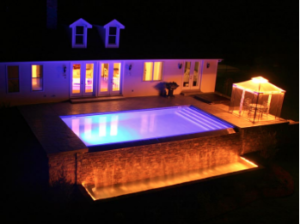Beyond the edge


The concept for vanishing edge pools is still new to many homeowners and as well as some builders. Whenever there’s a novel idea, you have to pay attention to details and pitfalls.
Speak up
As with any construction, the homeowner must communicate well with the contractor. Sometimes there’s a simple absence of understanding from homeowners of what to expect from a vanishing-edge pool and this is because the technology remains unfamiliar to the general public. Most people have an understanding of the basic workings of a standard 16-by-24-foot fiberglass pool, but the workings of a vanishing-edge pool are new to them.
One issue, in particular, comes up again and again with new vanishing-edge pool owners — an apparent leak in the catch pool.
According to some experts, clients think that they have a leak because the level of water in the catch pool drops a certain distance on a daily basis. But the evaporative loss in the main pool is reflected in the catch pool.
In a standard pool, evaporative loss is reflected in the slight lowering of its water level. But the water level in a vanishing-edge pool remains constant; losses at that point are concentrated in the catch pool, which is used to refill it and keep its level constant.
So water losses in the catch pool reflect evaporation not only from its own surface but the surface of the main pool, as well.
What makes the effect more dramatic is the smaller surface area of the catch pool. If the area of the main pool is 500 square feet and it loses a volume of water that would normally make its level drop 1 inch, the apparent loss of water in its catch pool of 50 square feet (a tenth of the main pool’s area) will be 10 times as great, or 10 inches — a shocking amount in a short time.
There might not be anything wrong, but the customer perceives that there is something wrong, and that becomes a sticking point for the builder. Problems worsen if the catch pool is too small for the pool it supports.
Make sure you have the ratio of surface area between the pool and the catch tank correct. So when you turn the pump on it runs the negative-edge flow — the water level in the catch tank falls below the level of the skimmers, and that causes a problem.”
Weir Wall
Mind the weir wall! Another tricky item is the weir wall, which, unlike the side of a standard pool, has water in contact on both sides.
Both sides of the weir should be waterproofed and since there are different types of waterproofing, you have to use products that are specific to the side you are waterproofing.
Valves
Finally, another trouble spot is the plumbing between the catch pool and the main pool, through which water is pumped to keep fluid spilling over the edge and back into the catch pool.
Since the catch pool is located below the main pool, when that pump is switched off, nature would like to drain all the water from the main pool down into the catch pool. A check valve in the line prevents this unless it fails.
Photos: Viking Pools